An insight into the relationship between language and religion in Lausanne Shaina Gormley and Jade Symons
Abstract
This analysis seeks to understand the connection between language and religion in Lausanne, Switzerland. The research focuses on images of signs advertising various religious centres and religious activities in the city of Lausanne. These images reveal the importance of language used in religious centres and its impact on the surrounding community. In order to find the religious centres, the researchers used a map of Lausanne and personal experience (walking past a religious centre daily or attending a religious centre). A diversity of religions are represented in this project in order to understand the diversity of languages used in religious centres. The researchers seek to answer “to what extent are the religious centres of Lausanne, Switzerland accommodating to speakers of non-national languages?”
- Introduction
Religion is inherently a diverse element of society with its plethora of different faiths and practices. However, religious practices within a culturally diverse country that has four national languages, makes it an ever more complex topic. This research aims at gaining a deeper knowledge of the relationship between language and religion in the city of Lausanne, Vaud. The overarching question we endeavour to reveal is to what extent are the religious centres of Lausanne accommodating to speakers of non-national languages? This is a niche area of interest and therefore the religious centre of Lausanne in relation to language has not been studied before. However, a wider look at this relationship within Switzerland has been analysed by some authors before such as a 1993 publication by the Swiss Federal Office of Statistics (Bureau fédéral de statistique, 1993). However, to respond to this question, our study analyses five religious spaces of Lausanne we selected looking at a map of Lausanne. We decided to pick a variety of different spaces that were located within the township of Lausanne. This paper will proceed first discussing the theoretical framework where we use the work of Blommaert and Marly and Mooney and Evans to define and conceptualise our study. Then a brief insight into the contextual background of the religious centres and religion within Lausanne. Further, this paper discusses the methodological approach for addressing this question, followed by final findings and a discussion of the results.
- Theoretical framework
According to Blommaert and Maly, linguistic landscaping refers to research documenting the visible signs of language in an urban setting. For example, billboards, road signs, restaurant signs, advertisements, etc., are all signs in a public space that demonstrate the language(s) used in an area. A public space in an urban setting is a place that is open to the public and part of a city. For our purposes, the public space is a religious centre and the urban setting is Lausanne, Vaud Switzerland. In addition, the city of Lausanne is defined by the city limits one would see on a map of the area. All religious centres included in this project included addresses that are within the city of Lausanne.
A religious centre is defined as a place where religious ceremonies, worship, and prayer services take place. However, religion does not need to be the primary activity at this place. For example, a community centre that also hosts religious events would be considered a religious centre for our purposes. In addition, the kind of signs discussed throughout this blog are difficult to define. Some signs resemble a commercial sign (advertisements), but do not fully adhere to what one might expect from a commercial sign. The signs throughout this project are found on or near religious centres which are informative to the public, not to designed to sell a product. Therefore, the signs will be referred to as commercial or left undefined due to the unique nature of the project.
Mooney and Evans define top-down signs as those produced by an official group, usually in an official language (2013). For example, signs created by the government or owners of a building or other sites are considered top-down. However bottom-up signs are produced on a local level by individuals or unofficial groups and often in languages other than the official language. An example of this would be a handwritten sign on an apartment door that says “Do Not Disturb.” This project will utilise both terms in order to accurately describe the origins of the signs. In addition, the type of sign reveals much to the reader. A bottom-up sign may be written in a creole language or language that is spoken by immigrants in the area. Although the sign is not written in an official language, the bottom-up sign may reveal the preferred language of the community, or show a minority language.
In Kouega and Emaleu’s research on church services in Anglophone Cameroon, specific terms such as “religious material” (hymns, catechism, and portions of scripture) are defined in order to analyse aspects of the church service or Catholic mass (2013). An analysis of the role of language throughout a religious service in Lausanne would be interesting in further research. However, for the purposes of this project, only signs outside of the religious centre will be used.
The following link provides an interactive map of the Lausannois religious centres in our study. It includes photographs and descriptions relevant to our research question.
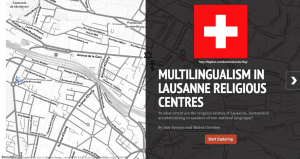
- Contextualisation
Our area of research is perhaps a little more unconventional than some of the other studies within our class. Collectively, we decided rather than researching the linguistic landscape and multilingual nature of one particular neighbourhood of Lausanne, that we would study the religious centres of the area and research into what they reveal about Lausanne and multilingualism. This was a simple choice as religion is a point of interest in both of our lives however, perhaps a more relevant motivation was that as exchange students, studying religious centres would lead to a deeper insight into the cultures, the communities, buildings and a better overall understanding of our host city. There is a plethora of other religious centres that would be relevant to this study however, we have limited our analysis of these spaces down to five. We selected these particular religious centres as they stem from a variety of different religions, denominations and languages within the city of Lausanne.
Therefore, the religious centres that we decided to analyse as part of our study are:
- Saint Gerasim Orthodox Church, Avenue de Florimont 2, Lausanne
- Synagogue of Lausanne, Avenue de Georgette 3, Lausanne
- Scottish Kirks Church (Church of Scotland), Avenue de Rumine 26, Lausanne
- Notre Dame Cathedral, Rue de Valentin 3, Lausanne
- Paroisse Saint-Jean, Chemin des Mouettes 4, Lausanne
Notre Dame Cathedral offers services in mainly French yet have Italian and Portuguese also. It is the most visited place of worship for the 11 000 practicing Catholics of Lausanne (Eglise Catholique dans le canton de Vaud, 2018). The second Christian centre, the Scottish Kirk’s Church, was established in 1876 in the area and has a very international community. The most recent census recorded 23 nationalities within their community (Scots Kirk Lausanne, 2018). Their services are exclusively in English. Furthermore, the Synagogue of Lausanne is a relatively recent addition to the religious landscape of Lausanne; being established in 1909. It has an extensive list of services and events for the Jewish community such as a restaurant, Kosher shop, educational facilities in addition to housing the Jewish Young Centre of Lausanne. The main languages used in the synagogue are Hebrew and French. What’s more, the main language used at the Paroisse Saint-Jean is French and Saint Gerasim Orthodox Church services in Greek. The Church of Saint-Jean’s parish was founded in 1915 and took inspiration from the Romanesque style of architecture.
- Methodology
Before collecting data we looked at a digital map of Lausanne, highlighting religious centres. We noted religious centres we saw in daily life, centres we have attended, and centres we were not aware of before finding them on a map. The search on the map revealed no shortage of religious centres in the city. We narrowed the choices by aiming to represent the diversity of religious centres as well as possible. In the end, the images chosen represent four different types of Christian churches and one Jewish synagogue. We chose signs that clearly represented the type of religious centre. It was important for us to find signs that were advertised not only for the general public, but in places where a current member of that religious centre would go to find information. A sign created solely for the public may only be in French primary official language of Lausanne), while a sign designed for members of the religious centre would likely be in the main language of communication in that religious centre.
It was surprising to find religious centres that represent such diverse languages and traditions. Protestantism and Catholicism are the most well-represented religions in Switzerland. However, it was surprising to see how easy it was to access these types of churches in languages other than French. We expected many Catholic churches in particular to be in French, with perhaps one English church. However, it was easy to find English church services of all denominations. In addition, it was surprising to find the Greek Orthodox Church with information almost entirely in Greek. We would not have been surprised to find church services in English or Spanish due to the more global nature of the languages, but Greek was surprising. In addition, it was interesting that we were unable to find religious centres in German or Swiss German. This indicates, perhaps, that religious centres in Lausanne represent religions on an international scale more thoroughly than Switzerland itself. In Lausanne preserving one’s culture and language are visible through religious centres and community.
- Results
The trends and major findings, both quantitative and qualitative, will be assessed in this section of the paper. This includes an analysis of the taxonomy regarding the signs and elements of the languages used in the religious centres such as the hierarchical relationship between the languages, the role of English in the signs (if any), the relationship of a specific language to the content of the signs and finally, an analysis of the conditions of production, if applicable. Further, this section contains results that are general to the study.
Quantitative Analysis
The table below discusses the proportion of signs that use the different languages. Note: The percentages do not equal 100% as some signs use more than one language.
| Percentage of Signs that Use | |
| English | 42.85% |
| French | 71.42% |
| Others | 57.14% |
Taxonomy of Messages
Many of the signs of this research did not categorise well into the types of signs that we have studied (regulatory, infrastructural, commercial and transgressive). The Scots Kirk’s signs can be considered as infrastructural as it indicates what the building is however, the other religious spaces are difficult to categorise. Other considerations might reveal that they can be considered commercial as they are selling or advertising a service however, this is also not a clear-cut way to define religious signs of Lausanne.
Qualitative Analysis
Saint Gerasim Orthodox Church
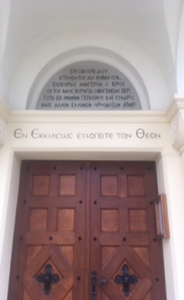
Conditions of production under certain linguistic policies and norms.
- In this instance we can see that linguistic norms are being followed; that Greek is expected to be used because the church follows Orthodox practices.
- This signage can be considered top-down.
Synagogue of Lausanne
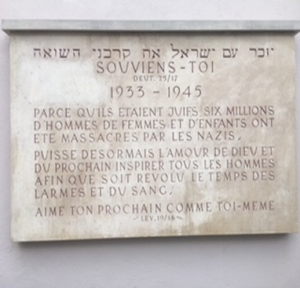
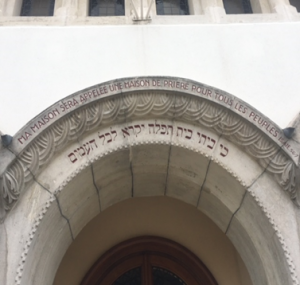
Hierarchical Relationship between languages in Contact
- Here we can see that French is used on the upper tier of the building which is a physical representation of the relationship between the two. However, French is also used to explain a memorial stone (top-image image). French is used as a functional language and represented more than Hebrew.
Conditions of Production under certain linguistic policies and linguistic norms
- Linguistic policies are followed as this sign is a top-down produced sign by officials however it follows linguistic norms as the presence of Hebrew shows.
Scottish Kirks Church
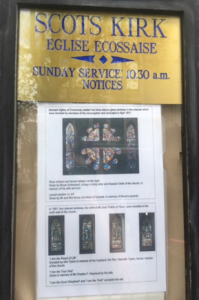
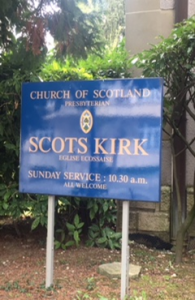
Hierarchical Relationship between languages in Contact
- English is the central language used, with a small use of French to describe that the space is an “Eglise Ecossaise”.
The role of English in Signs
- English is used to inform, signpost and describe in this sign however, the it is expected that English is the main language as the language of the denomination is English.
Conditions of Production under certain linguistic policies and linguistic norms
- This signage is both top-down and bottom-up. The left-hand image shows classified ads and information regarding the church which has been produced on a more micro level. It is in English which is the preferred language of the community.
Paroisse Saint-Jean
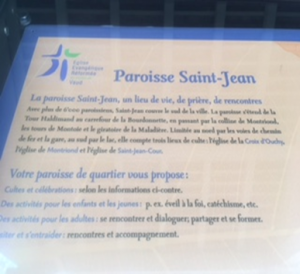
Role of English
- As it evident, English has no place in this sign. It shows that the language does is not relied on, nor a tongue used by the local community of the church.
Conditions of Production under certain linguistic policies and linguistic norms
- This is sign is Vaudois produced, as indicated in the top left-hand corner. Therefore we can categorise this sign as top-down and see that it falls within linguistic policies through the use of an official language (French) of the canton.
Basilique Notre Dame
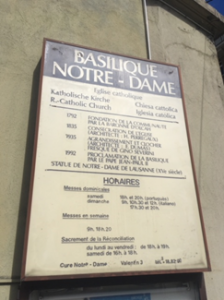
Hierarchical Relationship between languages in Contact
- Here we can see that French is used for both the place name, historical information and for a functional means; the timetable is in French. It is the primary language on the sign.s
The role of English in Signs
- English plays a very small role and is only represented to describe what type of religious space this is. It has no larger role than any other language in the space.
General Findings
The most apparent finding from the analysis of these religious signs is that English does not play such a central role as it does in an educational or professional sense in Switzerland (Ludi, 2013). The globalisation of English and its subsequent permeation is not clear from this analysis. A smaller percentage of the religious centres have English on their signs and often used in a purely functional manner. From this, one can suggest that English is not a homogeneous language of the religious landscape of Lausanne.
- Discussion
In light of the research presented above, it is clear that religious centres in Lausanne are accommodating to speakers of non-national languages. The signs outside religious centres indicate that a variety of languages and religions are represented in the city of Lausanne. The majority of the signs utilized French in some way. For example, the Jewish Synagogue included text memorialising the Holocaust in French primarily, with some Hebrew at the top of the sign. While others used French only to perhaps inform the French speakers of the area what type of religious centre it is (Eglise Ecosaisse-Scots Kirk Church), while primarily using English to display information.
It is clear that speakers of many languages and religions can attend the type of religious centre they prefer in Lausanne. While this project only includes a sample of the religious centres in the city, many others are available for speakers of non-national languages. In particular, a speaker of English will likely have little trouble finding a religious centre. About half the signs included English in some way. However, other languages such as Greek were also represented. While there is not research available on a similar linguistic landscaping project, Kouega and Emaleu’s research on church services in Anglophone Cameroon present an interesting comparison. The researchers found code-switching in informal parts of the church services (attendees talking with one another). It would be interesting to research if the signs outside the religious centres represent the languages spoken within. For example, does the Jewish Synagogue utilize Hebrew and French equally throughout a religious event? Or, are there other languages used as a lingua franca, such as English (common language between speakers who do not have the same mother tongue)? The linguistic landscape of religious centres in Lausanne provides an introduction into the multilingualism of the city. However, it is clear from this sample that religious centres do represent the diversity of Lausanne.
- Conclusion
From this analysis of the religious spaces within Lausanne, it can be commented that they are highly accommodating to speakers of non-national languages. The key findings of this study show that the categories of signs are not well suited for defining religious signage within Lausanne. Secondly, French is the primary language used by a multitude of faiths for both practical and religious purposes. Further, as previously indicated, this study reveals how English is not as central to life in Switzerland as some scholars such as Ludi may suggest (Ludi, 2013). It was French that prevailed the most, for both practical needs and as part of the religious communications. Here, one can suggest that French is the central language and the other languages act on a more localised level. However, this study included seven different languages which is indicative of the multicultural and diversity present within Lausanne. This highlights that a clear social transformation has taken place in Lausanne. Currently, it is one of the most culturally diverse cities in Switzerland, with residents from over 160 different countries and more than 40% of the city’s population is made up of foreigners (Suisse Office federal de la statistiques, 2018). The modern day religious landscape of Lausanne reveals hundreds of religious spaces from a plethora of different faiths. From viewing the religious centres of Lausanne, the social development and increasing multilingual nature of the city can be seen. These changes can be linked to the growth in migration to the area and religious toleration and accommodation of the city of Lausanne.
The analysis of language carries inherent limitations unless you can understand all the languages within your study. This was a clear limitation of our study. Foremost, as Anglophones who have a working knowledge of French, our comprehension of most of these signs was limited or non-existent. This made it difficult to compare the languages used within one space and analyse their hierarchical relationship, the use of the languages (whether they were used for functional or other use), in addition to understanding the relationship between content and language. To combat this issue, we used Google Translate when the script was the same as the English script however, translating Greek and Hebrew were particularly trying. A second limitation that we faced in our research was the classifications of signs. These religious signs did not fall squarely into the categories; commercial, infrastructural, transgressive or regulatory and thus, this made it difficult to understand how the religious centres in focus fit into the existing linguistic landscape discourse.
If this study was to be conducted again, there are a few areas that could be reconsidered or expanded on. Lausanne is a very multicultural and religiously diverse city. Evidently, this study was only a microanalysis of the role of languages within religious spaces of Lausanne. In the future it would be interesting and beneficial to conduct a more macro approach, that analyses language and religion extensively within Lausanne. This would include a larger sample of both the spaces and draw from a wider pool of faiths. What’s more, this research project included religious spaces only within the city of Lausanne, which again has a limiting effect. If this study were to be conducted again, the greater Lausanne areas such as Ecublens, Morges and south to Vevey could be considered.
In summation, this study has revealed how the religious spaces of Lausanne are accommodating to speakers of non-national languages. Multilingualism and religious diversity are embedded in the culture of Lausanne city.
BIBLIOGRAPHY
Eglise Catholique dans le canton de Vaud. (2018). Paroisse de Notre-Dame Lausanne. Retrieved May 26 2018, from http://www.cath-vd.ch/cvd_parish/notre-dame
Kouega, J.P., Emaleu, C.S. (2013). Language Choice in Multilingual and socio-religious settings in Southwest Cameroon. World Englishes, Vol. 32 (No.3), pp. 403-416. https://doi.org/10.1111/weng.12040
Lüdi, G. K. Höchle Meier and P. Yanaprasart. “Multilingualism and diversity management in companies in the Upper Rhine Region”. In: Berthoud, A.-C., F. Grin & G. Lüdi (eds.),
Exploring the Dynamics of Multilingualism: The DYLAN Project . 2013, pp 59–82.
Scots Kirk Lausanne, (2018). Retrieved 2018 from http://www.scotskirkslausanne.ch/
Suisse Office Fédéral de la statistique; Suisse. Bureau fédéral de statistique. (2018). Retrieved May 28, 2018.
Suisse Office Fédéral de la statistique; Suisse. Bureau fédéral de statistique. (1993). Langues et religions : tableaux thematiques. Eidgenossische Volkszahlung 1990, XXIX, 119. Retrieved May 26, 2018.
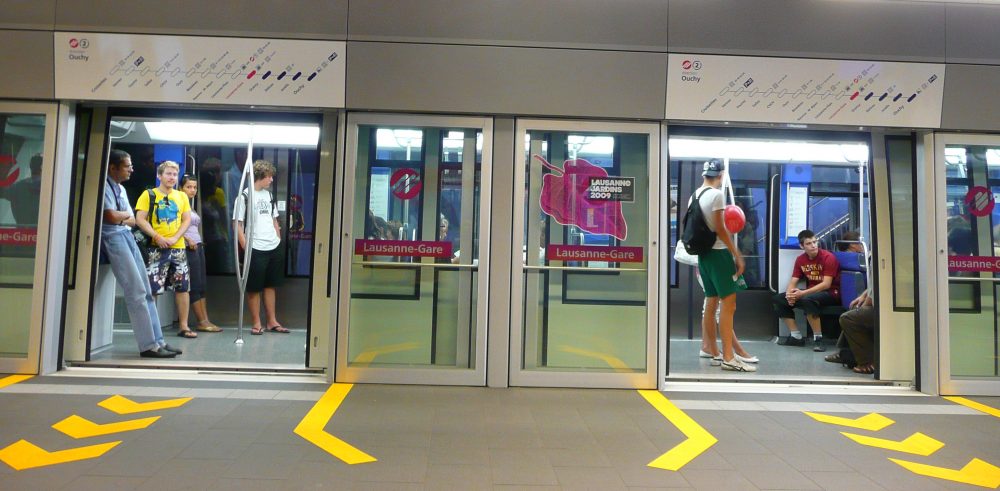
Hi. May I ask how am I supposed to cite this? Thank you.
HI there, this was a university project conducted by Jade Symons and Shaina Gormley. at UNIL. In a reference generator you should be able to pop in details found on this page. Best of luck
Hello! Thank you for your interest in this blog. This is the reference in APA 6th Edition:
Gormley, S. and Symons, J. (29th May, 2018). Language and Religion. In “Multilingual Lausanne: A linguistic landscape project”. Retrieved from: https://sepia2.unil.ch/wp/garrido/2018/05/29/language-and-religion/ [18th October 2018]